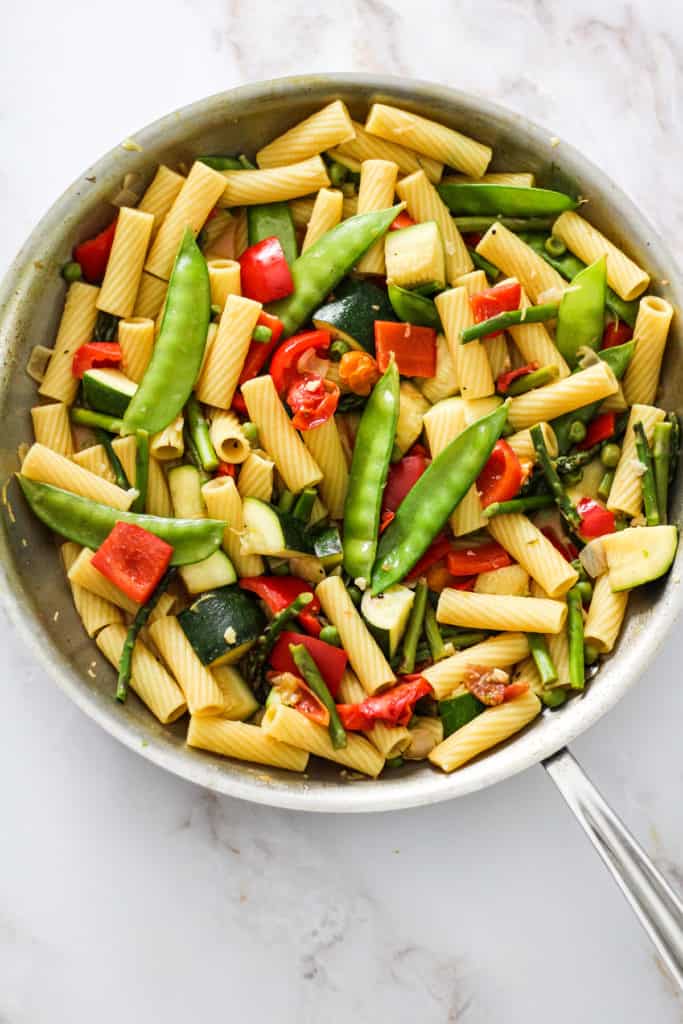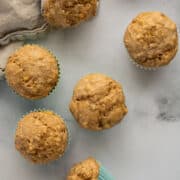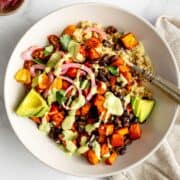Vegan Pasta Primavera is a plant-based version of the classic, Italian-American pasta dish with colorful vegetables tossed in a bright and flavorful lemon cream sauce.
This vegan version of pasta primavera includes a mix of fiber-rich vegetables like asparagus, peas, red bell pepper, zucchini, and cherry tomatoes for lots of added visual appeal. Instead of dairy-based milk or cream, the vegan sauce is made with plain oat milk.
Toss it all together with al dente rigatoni pasta (or any noodles of your choosing) and garnish with crunchy walnuts, fresh herbs, and spicy crushed red pepper to make this easy vegan weeknight dinner in just over half an hour.
The leftovers are also delicious for lunch the next day!

Is there anything more beautiful than a rainbow of fresh vegetables? The reds, greens, and yellows in this vegan pasta primavera dish...oh my. Be still my plant-based dietitian heart.
Dietitian or not, though, I think anyone can appreciate the beauty of this quick and easy Italian-American pasta recipe. Pasta Primavera is easy to whip up on a busy weeknight, and still eye-catching enough to make an appearance on your table for a dinner party or holiday event, too.
This veggie-packed main dish (of course, you can serve it as a side, too) is a great example of how I like to make pasta more satisfying and filling without incorporating any meat or dairy into the meal.
The trick is to load up your pasta bowl with plenty of fiber-rich veggies, which fill up the belly and help stabilize blood sugars so you can avoid energy crashes later on. Vegetables also add a ton of color and flavor, which is key for experiencing that crave-worthy satisfaction factor we're all looking for in our plant-based meals!

Grocery List
Here's what you'll need to make quick and easy vegan pasta primavera at home:
Fresh Produce:
- Asparagus
- Red bell pepper
- Zucchini
- Snow peas
- Cherry tomatoes
- Shallot
- Garlic
- Lemon
- Fresh basil (optional)
- Fresh parsley (optional)
Pantry Ingredients:
- Rigatoni pasta (or pasta of choice)
- Grapeseed oil (or cooking oil of choice)
- Vegetable broth
- Nutritional yeast or vegan parmesan cheese (optional)
- Crushed red pepper flakes (optional)
- Walnuts (optional)
Refrigerated and Frozen:
- Frozen peas
- Plain unsweetened oat milk (preferably full fat extra creamy)
Equipment
- 6-quart or larger pasta pot with a lid
- 12-inch skillet with a lid

Instructions
Time needed: 35 minutes
Summary: How to Make Vegan Pasta Primavera
- Cook the pasta
Boil dry pasta in salted water until al dente.
- Sauté the vegetables
Cook the vegetables in a skillet with oil until tender but still crisp.
- Cook the vegan pasta primavera sauce
Simmer the lemon cream sauce in the same skillet.
- Assemble and serve
Put it all together and add the optional garnish if desired.

Cooking the pasta:
I use dry rigatoni pasta for this recipe, but really, any type of noodle will do. Just be sure to adjust the cooking time according to the package instructions if you swap in a different type or shape.
Chickpea and lentil-based pasta also work well for this recipe and are a simple swap if you want to this dish gluten-free. You can also substitute a whole-wheat version if you want to up the fiber content.
To cook the pasta, first bring a six-quart (or larger) pot of water to a boil. Add salt and then pour in the dry pasta. Boil the pasta for about 12 minutes, or until it's al dente (tender but still firm).
Once cooked, drain the pasta and set it aside until you finish the vegetables and sauce in the following steps.

Sautéing the vegetables:
While the pasta is cooking, you can get started on the vegetables and sauce.
First, chop up all of the larger vegetables so they are a similar size (I like them to be about one inch in length).
Next, pour some oil into a 12-inch skillet over medium heat, tilting the skillet until it's evenly coated in oil. Stir in the vegetables: asparagus, red bell pepper, zucchini, snow peas, frozen peas, and cherry tomatoes.
Then, cover the skillet, and cook for about seven minutes, stirring occasionally, or until the vegetables are tender but still crisp. Season the vegetables with salt and pepper until they taste right to you.
Once the vegetables are cooked, transfer them from the skillet to a bowl or plate for safekeeping. You'll add them back into the skillet once the sauce is ready to go.

How to Make Vegan Pasta Primavera Sauce
The next step is cooking the dairy-free lemon cream sauce. Pour some more oil into the same skillet you used to cook the vegetables. Just like you did before sautéing the veggies, tilt the pan so that it's evenly coated in the oil before you start.
Then, stir in the diced shallot and cook for about three minutes, or until it turns translucent and fragrant. Stir in some garlic and grated lemon peel next.
Once the lemon and garlic are fragrant, pour in the vegetable broth and simmer uncovered until the volume is reduced in half.
Next, stir in the oat milk and lemon juice. You can also add the nutritional yeast or vegan parmesan cheese at this point if you're using it. Stir and cook the sauce until it's hot and the oat milk is no longer streaky.
Feel free to taste the sauce at this point and make adjustments to the flavorings as you see fit.

Assembling the Vegan Pasta Primavera:
Now comes the fun part—putting it all together!
Add the cooked pasta and vegetables back into the skillet with the vegan pasta primavera sauce. Stir the mixture until the pasta and veggies are evenly coated with the sauce and it's all warmed up.
Finally, transfer the pasta mixture to a serving dish and spoon any remaining sauce on top. Garnish the pasta with fresh basil and parsley leaves, crushed red pepper flakes, nutritional yeast or vegan parmesan cheese, chopped walnuts, and more lemon if desired.

Nutrition Highlights
- The colorful vegetables in this recipe contain beneficial phytonutrients and are also a rich source of fiber, which helps stabilize blood sugars and make you feel satisfied and full.
- Feel free to load up on the crunchy walnuts! Walnuts are a rich source of polyunsaturated fats (also called PUFAs) and they also add some protein and the plant-based version of essential omega-3s.
- Pasta provides carbohydrates, the primary source of fuel for your brain, and a macronutrient that's important for athletic performance.
Meal Prep and Storage
This Vegan Pasta Primavera tastes great leftover (you can even eat it cold!). If you want to prep it in advance, just store the prepared pasta in an airtight container and refrigerate it for up to five days.
For more easy, plant-based recipes you can make ahead of time, check out my free 3-Day Plant-Based Meal Prep Plan e-book:

Ingredient Substitutions
- Try swapping in any of your favorite colorful vegetables to make this pasta primavera dish. Broccoli or broccolini, yellow summer squash, spinach, mushrooms, artichoke hearts, and carrots are all tasty options.
- Use any type of pasta you have on hand. Feel free to switch up the shape, swap in lentil or chickpea-based pasta, or use a whole-wheat variety if preferred.
- If you don't have grapeseed oil, swap in whatever oil you typically use for cooking.
- Instead of a shallot, you could substitute ¼ cup diced onion.
- Substitute chopped pecans, chopped almonds, or sunflower seeds for the walnuts.

Best Recipes to Serve With:
Add one of these easy vegan side dishes to make your pasta dinner complete.
- Meal Prep Salad
- Vegan Roasted Cabbage Caesar Salad
- Vegan Potato Soup with White Beans
- Easy Tomato Carrot Soup with Herb Fried Bread
- Roasted Rainbow Carrots with Citrusy Maple Ginger Glaze

Frequently Asked Questions for Vegan Pasta Primavera
To make this recipe gluten-free, substitute chickpea or lentil pasta and confirm that the oat milk is certified gluten-free.
Substitute sunflower seeds for the walnuts, and use nutritional yeast instead of a nut-based vegan parmesan. Conversely, you may also omit the walnuts and vegan parmesan/nutritional yeast from this recipe.
This vegan pasta primavera may be prepped in advance. Store the prepared pasta in an airtight container and refrigerate for up to five days.
📖 Recipe

Vegan Pasta Primavera
Equipment
- 6-quart or larger pasta pot with lid
- 12-inch skillet with lid
Ingredients
Pasta:
- 2 cups dry rigatoni pasta or pasta of choice
Vegetables:
- 1 tablespoon grapeseed oil or as needed to coat pan
- 1 cup chopped asparagus, 1-inch pieces
- 1 red bell pepper, chopped into 1-inch pieces
- 1 medium zucchini, chopped into 1-inch pieces
- 1 cup snow peas
- ½ cup frozen peas
- ½ cup halved cherry tomatoes
- Salt and pepper to taste
Sauce:
- 1 tablespoon grapeseed oil or as needed to coat pan
- 1 medium shallot, diced
- 4 cloves garlic, minced or grated
- 1 tablespoon grated lemon peel (optional)
- 1 cup vegetable broth
- ½ cup plain unsweetened oat milk (preferably full fat extra creamy)
- 2 tablespoons lemon juice
- 2 tablespoons nutritional yeast or vegan parmesan cheese (optional)
Optional garnish:
- Fresh basil and parsley leaves
- Crushed red pepper flakes
- Nutritional yeast or vegan parmesan cheese
- Chopped walnuts
- Lemon (grated lemon peel, lemon juice, and lemon slices)
Instructions
Cook pasta:
- Bring a 6 quart (or larger) pot of salted water to a boil. Add pasta and cook for 12 minutes, or until al dente. Drain pasta and set aside.
Cook vegetables:
- In the meantime, pour grapeseed oil into a 12-inch skillet over medium heat, tilting the skillet until it is evenly coated. Stir in asparagus, red bell pepper, zucchini, snow peas, frozen peas, and cherry tomatoes, cover, and cook for 7 minutes, or until the vegetables are tender but still crisp. Season with salt and pepper to taste.
- Transfer the cooked vegetables to a bowl or plate and set aside.
Cook sauce:
- Pour grapeseed oil into the same skillet used to cook the vegetables, tilting the pan until it is evenly coated.
- Stir in shallot and cook for 3 minutes, or until translucent. Stir in garlic and lemon peel and cook for 1 minute, or until garlic is fragrant.
- Stir in vegetable broth and cook uncovered for 8 minutes, or until the volume is reduced in half.
- Stir in oat milk, lemon juice, and nutritional yeast or vegan parmesan cheese (if using), and stir and cook until the sauce is hot and no longer streaky.
Assemble and serve:
- Add the cooked pasta and vegetables to the skillet and stir until they are evenly coated with the sauce and the mixture is hot.
- Transfer pasta mixture to a serving dish, spoon any remaining sauce on top, and garnish with fresh basil and parsley leaves, crushed red pepper flakes, nutritional yeast or vegan parmesan cheese, chopped walnuts, and lemon if desired.
Notes
Nutrition
If you loved this Vegan Pasta Primavera Recipe, please leave a five-star review on the recipe card above!
Save this recipe on Pinterest:

If you share your re-make on Instagram, be sure to tag me (@GratefulGrazer and #GratefulGrazer). I'd love to see your photos and videos!




















Carol Turner says
I am confused. If I make this ahead of time do I go ahead and combine it and cook it and store it to be reheated the next day or do I just leave all the ingredients separate? And actually cook it when I serve it.
Stephanie McKercher, RDN says
Hi Carol, you can prepare the whole thing in advance! It helps to cook the pasta until just before al dente so it doesn't get too soft when you reheat it. Let me know if you have any other questions!
Carolyn says
Delicious and so easy. Thanks for this great recipe!
Stephanie McKercher, RDN says
So glad you enjoyed it! Thanks for leaving a comment, Carolyn!